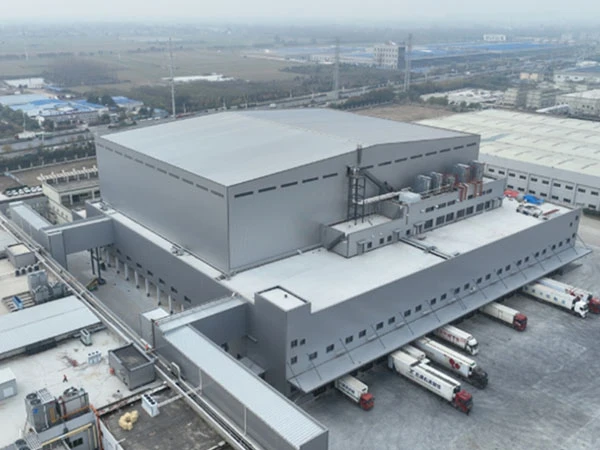A steel structure warehouse can have a service life of 50 to 100 years or even longer, but this depends on a variety of factors. The durability and longevity of a steel building are heavily influenced by its design, the quality of materials used, the environment it's in, and how well it is maintained.
A well-designed, properly constructed, and regularly maintained steel structure warehouse has a typical design life of 50 years and an actual service life of 50 to 100 years, or even longer.
Design Life (50 years): This is the standard period that engineers use for calculations according to building codes. It means the structure is designed to safely withstand all anticipated loads (snow, wind, seismic activity) for at least 50 years without major structural failure.
Actual Service Life (50-100+ years): This is how long the building can actually be used. With proper care and maintenance, the primary steel frame can easily outlast its 50-year design life.

1. Design and Engineering Quality
This is the foundation for a long service life.
Load Calculations: Was the building engineered for the correct wind, snow, and seismic loads for its specific location? An under-engineered building will fail prematurely.
Corrosion Allowance: In corrosive environments, was a thicker steel or a more robust coating system specified in the design?
Drainage Design: Proper roof slope and gutter/downspout design are crucial to prevent water from pooling, which is a primary cause of corrosion.
2. Quality of Materials & Coatings (The #1 Factor for Longevity)
Steel's main enemy is rust (corrosion). The protective coating is everything.
Primary Steel Frame (Beams & Columns): Usually protected with a high-quality primer and paint. If properly applied in a controlled factory environment, this coating can last for decades before needing maintenance.
Secondary Framing (Purlins & Girts): These are often made of pre-galvanized steel. Hot-dip galvanizing provides a much thicker, more durable zinc coating and offers superior protection, significantly extending service life, especially in humid or coastal areas.
Roof and Wall Panels: The quality of the paint finish is critical. Modern systems like SMP (Silicone-Modified Polyester) or PVDF (Kynar 500®) come with 20 to 40-year warranties against chalking, fading, and peeling. The underlying metal is often Galvalume® (a zinc-aluminum alloy) which has excellent corrosion resistance.
3. Environmental Conditions
Where the warehouse is located plays a massive role.
Dry, Arid Climate: A steel building can last indefinitely with minimal maintenance.
Humid/High Rainfall Climate: Constant moisture increases the risk of corrosion. Good drainage and ventilation are essential.
Coastal/Marine Environment: Salt spray is extremely corrosive to steel. Buildings within a few miles of the coast require hot-dip galvanized framing and high-performance panel coatings (like PVDF) to survive.
Industrial/Polluted Area: Acid rain and chemical exposure can accelerate the degradation of coatings and steel.
4. Quality of Construction and Installation
A great design can be ruined by poor installation.
Handling: Scratching or damaging panels and framing during transport and erection creates an immediate weak point for rust.
Fasteners: Using the wrong type of screws or over-tightening them can break the protective washer seal, allowing water to penetrate the structure at every screw point.
Welding: On-site welds must be properly cleaned and immediately primed/painted to prevent flash rusting.
5. Maintenance and Inspection
A steel warehouse is low-maintenance, not no-maintenance. A proactive approach is key to reaching a 100-year lifespan.
Regular Inspections (Annual): Check for scratches, signs of rust, loose fasteners, and sealant failures.
Gutter Cleaning: Clogged gutters cause water to back up under the roof panels, leading to corrosion and leaks.
Washing: Periodically washing the roof and walls (especially in coastal or industrial areas) removes corrosive deposits.
Prompt Repairs: Touching up a small scratch with paint is an easy, cheap fix. Letting it rust through requires a much more expensive repair.

The main frame will last the longest, but other components will need replacement sooner.
|
Component |
Typical Service Life |
Key Factors |
|
Primary Steel Frame |
50 - 100+ years |
Coating quality, environment |
|
Roof Panels |
20 - 40 years |
Paint system (PVDF > SMP), environment, maintenance |
|
Wall Panels |
25 - 50 years |
Less direct sun/weather exposure than the roof |
|
Fasteners & Sealants |
15 - 25 years |
Washer quality (EPDM), UV exposure, installation |
|
Gutters & Downspouts |
15 - 30 years |
Material (galvanized vs. aluminum), debris, cleaning |
|
Insulation |
20 - 50+ years |
Can be damaged by leaks or pests |
|
Overhead Doors |
15 - 25 years |
Mechanical wear and tear, frequency of use |
To maximize the life of a steel structure warehouse:
Invest Upfront: Don't cut corners on design, material quality, or coatings. Choosing hot-dip galvanizing or a premium PVDF paint system will pay for itself many times over.
Hire Professionals: Ensure the building is erected by an experienced crew that understands how to handle the materials correctly.
Implement a Maintenance Plan: Create a simple annual checklist to inspect the building, clean gutters, and address any minor issues before they become major problems.
By following these principles, a steel structure warehouse is an incredibly durable and long-lasting investment that can easily serve its purpose for generations.
A Comprehensive Analysis of Quality Acceptance Standards for Prefabricated Steel Structure Projects: From Materials to Construction to Safety and Aesthetics
2025-12-11Steel structure reinforcement and renovation of old industrial plants: a practical solution to ensure safety and extend lifespan.
2025-12-05Turnkey Steel Structure Factory Solutions: The Ultimate Way to Build Efficient, Cost-Effective, and Scalable Industrial Facilities
2025-11-24Step-by-Step Guide to Building a Steel Structure Factory: Key Processes for a Durable and Efficient Industrial Facility
2025-11-19Address: No.1 Shuangxiang Road, Luoxin Industrial Park, Luoyang City
E-mail: info@hcggsteel.com
Hotline: +8618800767079

Create the greatest value for customers
Provide the best quality products and services
+8618800767079
info@hcggsteel.com
No.1 Shuangxiang Road, Luoxin Industrial Park, Luoyang City